Plymouth
Plymouth has been and still is the most important city in Devon as well as its cultural capital, although Exeter is the county capital. It can also be argued that it has been and still is one of the important cities of the country.
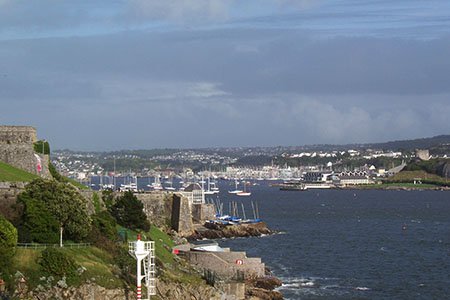 Plymouth
PlymouthThe city from which the modern world was formed.
Photo and Copyright - L Temple
It can even be argued that this was the city from which the modern world was formed.
This is the city where Drake played bowls before he left to defeat the Armada, and left for his circumnavigation of the world. This is the city where the Pilgrim Fathers left for the New World. This is the city where Captain Cook left for the Pacific, New Zealand and Australia. From where two ships of the First Fleet to Australia sailed and ships for the colonisation of New Zealand.
Charles Darwin left on the "Beagle" and his survey of the Galapagos Islands from which he wrote his “Origin of Species”. A son of the city, Scott of the Antartic, left on the "Discovery" for his expedition to the South Pole. In more recent times it is the port from which Sir Francis Chichester left for his circumnavigation of the world.

The Barbican
In the footsteps of Sir Walter Raleigh, Sir Francis Drake, Captain Cook and John Hawkins, the passengers of the Mayflower and thousands of sailors, the visitors of the modern era all walk these narrow streets.
It is the centre of the history of the city. The Barbican survived the World War II Blitz. Now Its narrow historic streets amaze, a myriad of small intriguing shops and art galleries. A focal point for antique collectors and art lovers.

Island House
The Tourist Information Centre. It is said that some of the Pilgrim Fathers spent their last night in England in this old building. It overlooks Sutton Harbour from where they were to set sail the next day. For those who wish to trace their ancestry, or are just interested, a plaque names those brave pilgrims.

The Mayflower Steps
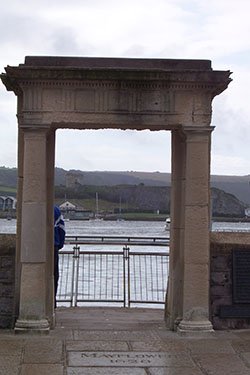 The Mayflower Steps
The Mayflower StepsPhoto and Copyright L Temple
On 6th September 1620, 102 passengers and 48 seamen walked down the steps into history. The Pilgrim Fathers left for their 66 day voyage on “The Mayflower” to The New World.
Plaques around these steps commemorate other historic departures that shaped the modern world:
"Plymouth Men who Helped to Found the Modern Australia" includes:
Captain Tobias Furneaux who charted the coast of Tasmania 1773.
Captain John MacArthur who introduced the merino sheep to Australia 1790's.
Captain William Bligh of “Bounty” fame and became Governor of NSW 1806-1809.
Colonel George Arthur Lt Governor of Tasmania 1823-1836.
Major Edmond Lockyer raised the flag in Western Australia 1827.
The plaque also notes that Furneaux and Bligh were on Captain Cook's second voyage of discovery which left Plymouth in 1772.
Captain Cook's other two voyages left from Plymouth in 1768 and 1776.
From Plymouth on 13th March 1787 sailed the transport ships “Friendship” and “Charlotte” carrying men and women convicts bound for Australia. On 28th January 1788, with nine other ships from England they landed at Port Jackson which became Sydney, New South Wales. There they established the first British colony under the Command of Captain Arthur Phillip R.N. the father of modern Australia. (The First Fleet. An event as important to Australia as was the “Mayflower” to America”)
The departure from Plymouth of pioneer ship “Tory” in the colonisation of New Zealand in May 1839.
Another plaque commemorates six Plymouth company vessels carrying
settlers from Cornwall, Devon and Dorset to establish to settlement of
New Plymouth in New Zealand in 1841 and 1842.
"William Bryan”, Amelia Thompson”, “Oriental”, “Timandra”, “Blenheim”, and the “Essex”.
From near this spot thousands of Cornish people sailed to South Australia during the nineteenth century.
And one from the twentieth century: The arrival of the American
seaplane N.C.4 in Plymouth Sound on the completion of the first
Transatlantic Flight on 1st May 1919.

The Merchant's House
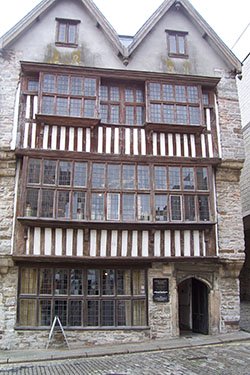
The Merchants House
Photo and Copyright L Temple.
Dating from 1548, forty years before the Armada. It was a sea captain's house, William Parker, a friend of Sir Francis Drake and Mayor of Plymouth in 1601. It has its original windows and a spiral staircase that winds around an old ship's mast. An attractive restoration of one of Plymouth's heritage houses.
From the sixteenth and seventeenth centuries The Merchant's House, is an absorbing journey into the city's past. Plymouth is a remarkable city.
This attraction has been closed. It would be worth checking if it has opened again.

Elizabethan Garden
For a haven from sightseeing - walk in The Elizabethan Garden, for some quiet reflection by the ornamental pool. Authentic Elizabethan gardens of colourful flowers, herbs, small box hedges, cobbled paths, steps and stone seats.

The National Marine Aquarium
One for all the family. Startling. It is Europe's deepest and Britain's largest aquarium. Over a hundred species and over a thousand specimens. Immerse yourself in the natural history of the oceans. Take the children to visit the secret and magical world of the seahorses. Peep into rock pools on the seashore. Visit the majestic Atlantic Reef and watch an alien world of creatures of the deep. Marvel at the incredible Mediterranean Ravine. Stare with wonder at Coral Seas. A totally unforgettable experience. There is wheelchair access.

Plymouth Hoe
The Hoe is a large open green space facing south above the seafront with a red and white lighthouse in the middle. From the Hoe the views across the Sound are to say the least magnificent, right over to Drakes Island and the coast of Cornwall.
The most famous part of Plymouth – where Sir Francis Drake is said to have finished his game of bowls before he went off to defeat the Armada. There is a statue of him on the Hoe, perhaps it was here that the game was played. He would have certainly had a good view of the Sound.
Today there is plenty of activity to watch from the Hoe, Royal Naval warships, ferries to France and Spain, fishing trawlers, and sailing boats creating patterns of colour and movement on the water.
Every other year the Fastnet Yacht race, 608 miles, from Cowes on the Isle of Wight, rounds the Fastnet Rock on the southwest coast of Ireland and finishes at Plymouth. The Hoe makes a good vantage point.

Smeaton's Tower
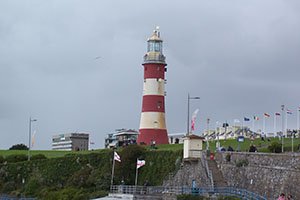
Smeaton's Tower
Photo and Copyright L Temple.
The red and white lighthouse on the Hoe. It was not built there originally but was the third lighthouse to stand on Eddystone Reef, a treacherous group of rocks about fourteen miles to the south west. It was built in 1759 and its light shone to warn shipping for 125 years. It was found that the action of the sea was undermining the structure and the top two thirds was re erected stone by stone on the Hoe in 1884. It has stood here as long as it was on Eddystone Reef. The remains of the bottom third are still on Eddystone Reef.
The tower was an important improvement to the construction of lighthouses, John Smeaton built this one with granite blocks on the outside and Portland stone for the interior. His design was robust and gave the lighthouse a low centre of gravity to deal with the storms it encountered.
The lighthouse is owned by the Plymouth Museum and can be visited, if you do not mind 93 steps. It is 72 ft high and the views from the lantern room are incredible both towards the Sound and the city. Well worth the climb. Don't forget the camera or you will have to come again!

The Citadel
The city was for the Roundheads during the Civil War. When Cromwell died and Charles II was crowned, the city was suspect as to its loyalty – among other places. The Royal Citadel was built ostensibly to protect the port, but the guns pointed to the town as well....

Plymouth Dome
It is in what was an old quarry - now its a walk through time in a set of themed galleries with some remarkable and amusing exhibits. Want a set of Drakes Bowls? Have a look in the shop. The observation gallery gives another panoramic view over the Sound.
What is a disabled car park on a long tarmac promenade is also a highly spectacular military parade ground. Here bands of the Royal Navy, the Royal Marines and the Army play on ceremonial occasions. It is also the place for all the fun of the fair and a delightful venue for open air concerts.

The Royal Navy
Plymouth has been a premier Naval port for centuries, second only to Portsmouth. Situated in the deep waters of the Sound on the mouth of the Rivers Tamar and Plym it has an ideal location.
Devonport Dockyard on the River Tamar is the largest in Europe in arguably one of the most beautiful natural harbours perhaps in the world. Four miles of waterfront location.
William II, or William of Orange as he was known, had the dockyard built in 1689, but it was originally the idea of Sir Walter Raleigh. William did not want to have the dockyard at Plymouth and the current site was decided on.
Boat trips can be taken up the River Tamar to view the ships and the dockyards. The Tamar forms most of the boundary between Devon and Cornwall.
Navy Days in August is a three day event when most of Devonport Dockyard to open to the public. A popular occasion.

The City of Plymouth
The city of Plymouth, like Coventry and other cities, rose from the ashes of the Blitz of World War II in concrete. It was the most practical solution. Perhaps these utiliteran buildings are getting past their use by date for modern buildings are appearing, bars, restaurants, modern shoppoing centre and the restoration of the old, much loved Grade II listed, ornate art deco Tinside Lido.
Indulge in Retail Therapy in the indoor Pannier Market or the new Drakes Circus. The Bright Lights - party till the early hours, why not. International food, or local, in the many restaurants. Fine Wine, real ale, beer? A show at the Theatre Royal – Plymouth has it all.

Plymouth Museum and Art Gallery
opposite the University. The complex has undergone refurbishment, This includes the Cottonian Collection gifted in 1852 by William Cotton, a resident of nearby Ivybridge , and includes his collection of the paintings of his friend, Joshua Reynolds.

Famous People of Plymouth
Sir John Hawkins 1532-1595 Admiral and Slave trader.
Joseph Glanvill 1636-1680 Philosopher and Author.
William Snow Harris 1791-1867 Physicist. Inventor of the lightning rod for ships.
Richard Greene 1918-1985 Actor. Television - “Adventures of Robin Hood”.
Acted in the 1939 version of the film “The Hound of the Baskervilles”
from an eerie novel by Sir Arthur Conan Doyle set on Dartmoor nearby.
Donald Moffatt b 1930 Actor.
Sir Donald Sinden CBE b 1923 Actor.
Sir Dingle Macintosh Foot QC 1905-1978 Member of Parliament.
Hugh, Lord Caradon 1907-1990 Diplomat and Life Peer.
John, Lord Foot 1909-1999 Politician and Life Peer.
Michael Macintosh Foot b 1913-2010 Politician and Author.

Accommodation
Plymouth is situated in an area of outstanding natural beauty. It is an ideal spot for touring Devon.
The city itself needs at the very least two days to make the most of this remarkable place. Yes, it would make a very nice break on its own.

Other pages that may be of interest

Or you may prefer to browse some more, please do, there are navigation buttons above on the left.

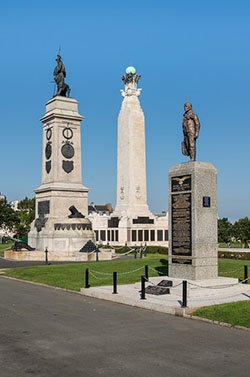
Three memorials on Plymouth Hoe. In the background is the 1924 Naval War Memorial with the 1888 Armada Memorial on the left and the 1989 RAF and Allied Air Forces Memorial on the right.
Photograph © Ian Capper

Useful Information
Find My Past, Forces War Records and Ancestry are handy resources for finding records for the names on memorials.

Things change. Always check out the external links for the latest information.
These are just helpful suggestions only.
There is only one affiliate link, SBI.
Travel Wessex is a Guide.


This is a developing map. Some areas have better coverage.
To find the nearest Electric Vehicle Charging Point please click here.

Public Transport
If you do decide the leave the car at home and help the environment too, why not go National Express. They run coaches all over the country. Some pretty good fares too.
Just imagine - sit back and relax, no hassling with the traffic!!!
Do you know that you can book on your mobile phone and they will send the ticket as a text!!!!

National Rail Journey Planner.
For train journeys all over the United Kingdom connecting the places you want to go efficiently and quickly.

Traveline is a very useful resource for public transport throughout Wessex, even local buses. In fact all over the United Kingdom.



